Jialu Wang
Infi-Med: Low-Resource Medical MLLMs with Robust Reasoning Evaluation
May 29, 2025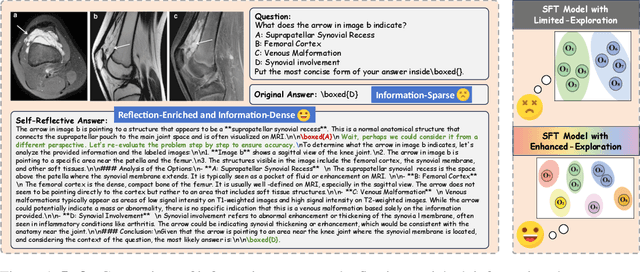
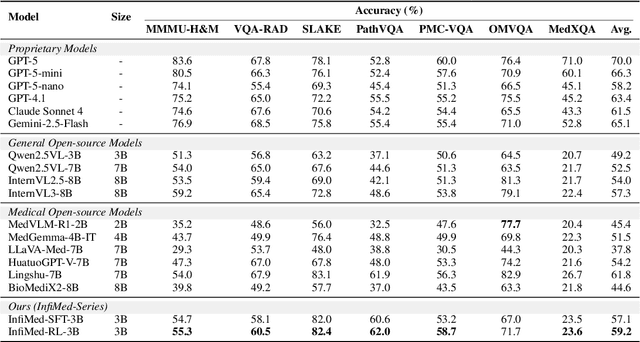


Abstract:Multimodal large language models (MLLMs) have demonstrated promising prospects in healthcare, particularly for addressing complex medical tasks, supporting multidisciplinary treatment (MDT), and enabling personalized precision medicine. However, their practical deployment faces critical challenges in resource efficiency, diagnostic accuracy, clinical considerations, and ethical privacy. To address these limitations, we propose Infi-Med, a comprehensive framework for medical MLLMs that introduces three key innovations: (1) a resource-efficient approach through curating and constructing high-quality supervised fine-tuning (SFT) datasets with minimal sample requirements, with a forward-looking design that extends to both pretraining and posttraining phases; (2) enhanced multimodal reasoning capabilities for cross-modal integration and clinical task understanding; and (3) a systematic evaluation system that assesses model performance across medical modalities and task types. Our experiments demonstrate that Infi-Med achieves state-of-the-art (SOTA) performance in general medical reasoning while maintaining rapid adaptability to clinical scenarios. The framework establishes a solid foundation for deploying MLLMs in real-world healthcare settings by balancing model effectiveness with operational constraints.
MambaLoc: Efficient Camera Localisation via State Space Model
Aug 20, 2024



Abstract:Location information is pivotal for the automation and intelligence of terminal devices and edge-cloud IoT systems, such as autonomous vehicles and augmented reality. However, achieving reliable positioning across diverse IoT applications remains challenging due to significant training costs and the necessity of densely collected data. To tackle these issues, we have innovatively applied the selective state space (SSM) model to visual localization, introducing a new model named MambaLoc. The proposed model demonstrates exceptional training efficiency by capitalizing on the SSM model's strengths in efficient feature extraction, rapid computation, and memory optimization, and it further ensures robustness in sparse data environments due to its parameter sparsity. Additionally, we propose the Global Information Selector (GIS), which leverages selective SSM to implicitly achieve the efficient global feature extraction capabilities of Non-local Neural Networks. This design leverages the computational efficiency of the SSM model alongside the Non-local Neural Networks' capacity to capture long-range dependencies with minimal layers. Consequently, the GIS enables effective global information capture while significantly accelerating convergence. Our extensive experimental validation using public indoor and outdoor datasets first demonstrates our model's effectiveness, followed by evidence of its versatility with various existing localization models. Our code and models are publicly available to support further research and development in this area.
Long-Term Fairness Inquiries and Pursuits in Machine Learning: A Survey of Notions, Methods, and Challenges
Jun 10, 2024



Abstract:The widespread integration of Machine Learning systems in daily life, particularly in high-stakes domains, has raised concerns about the fairness implications. While prior works have investigated static fairness measures, recent studies reveal that automated decision-making has long-term implications and that off-the-shelf fairness approaches may not serve the purpose of achieving long-term fairness. Additionally, the existence of feedback loops and the interaction between models and the environment introduces additional complexities that may deviate from the initial fairness goals. In this survey, we review existing literature on long-term fairness from different perspectives and present a taxonomy for long-term fairness studies. We highlight key challenges and consider future research directions, analyzing both current issues and potential further explorations.
WSCLoc: Weakly-Supervised Sparse-View Camera Relocalization
Mar 22, 2024Abstract:Despite the advancements in deep learning for camera relocalization tasks, obtaining ground truth pose labels required for the training process remains a costly endeavor. While current weakly supervised methods excel in lightweight label generation, their performance notably declines in scenarios with sparse views. In response to this challenge, we introduce WSCLoc, a system capable of being customized to various deep learning-based relocalization models to enhance their performance under weakly-supervised and sparse view conditions. This is realized with two stages. In the initial stage, WSCLoc employs a multilayer perceptron-based structure called WFT-NeRF to co-optimize image reconstruction quality and initial pose information. To ensure a stable learning process, we incorporate temporal information as input. Furthermore, instead of optimizing SE(3), we opt for $\mathfrak{sim}(3)$ optimization to explicitly enforce a scale constraint. In the second stage, we co-optimize the pre-trained WFT-NeRF and WFT-Pose. This optimization is enhanced by Time-Encoding based Random View Synthesis and supervised by inter-frame geometric constraints that consider pose, depth, and RGB information. We validate our approaches on two publicly available datasets, one outdoor and one indoor. Our experimental results demonstrate that our weakly-supervised relocalization solutions achieve superior pose estimation accuracy in sparse-view scenarios, comparable to state-of-the-art camera relocalization methods. We will make our code publicly available.
Fair Classifiers Without Fair Training: An Influence-Guided Data Sampling Approach
Feb 20, 2024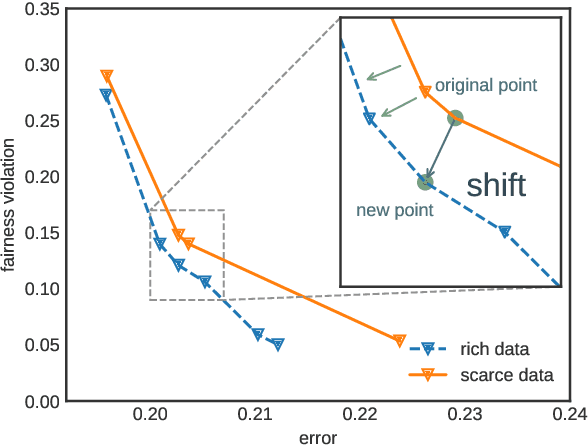
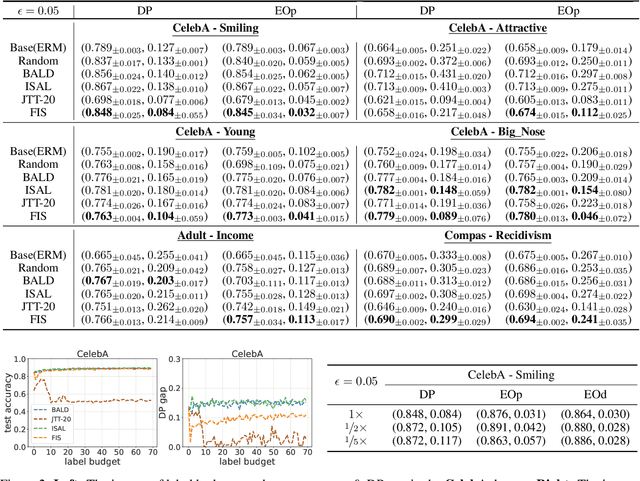
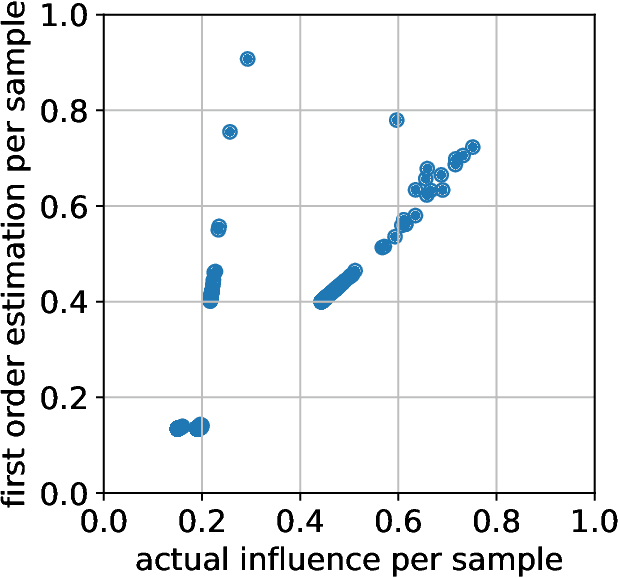
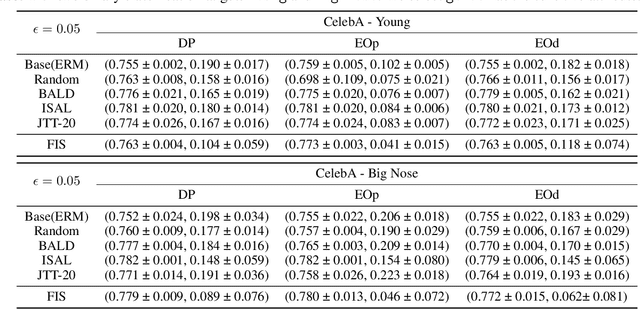
Abstract:A fair classifier should ensure the benefit of people from different groups, while the group information is often sensitive and unsuitable for model training. Therefore, learning a fair classifier but excluding sensitive attributes in the training dataset is important. In this paper, we study learning fair classifiers without implementing fair training algorithms to avoid possible leakage of sensitive information. Our theoretical analyses validate the possibility of this approach, that traditional training on a dataset with an appropriate distribution shift can reduce both the upper bound for fairness disparity and model generalization error, indicating that fairness and accuracy can be improved simultaneously with simply traditional training. We then propose a tractable solution to progressively shift the original training data during training by sampling influential data, where the sensitive attribute of new data is not accessed in sampling or used in training. Extensive experiments on real-world data demonstrate the effectiveness of our proposed algorithm.
Unmasking and Improving Data Credibility: A Study with Datasets for Training Harmless Language Models
Nov 19, 2023



Abstract:Language models have shown promise in various tasks but can be affected by undesired data during training, fine-tuning, or alignment. For example, if some unsafe conversations are wrongly annotated as safe ones, the model fine-tuned on these samples may be harmful. Therefore, the correctness of annotations, i.e., the credibility of the dataset, is important. This study focuses on the credibility of real-world datasets, including the popular benchmarks Jigsaw Civil Comments, Anthropic Harmless & Red Team, PKU BeaverTails & SafeRLHF, that can be used for training a harmless language model. Given the cost and difficulty of cleaning these datasets by humans, we introduce a systematic framework for evaluating the credibility of datasets, identifying label errors, and evaluating the influence of noisy labels in the curated language data, specifically focusing on unsafe comments and conversation classification. With the framework, we find and fix an average of 6.16% label errors in 11 datasets constructed from the above benchmarks. The data credibility and downstream learning performance can be remarkably improved by directly fixing label errors, indicating the significance of cleaning existing real-world datasets. Open-source: https://github.com/Docta-ai/docta.
T2IAT: Measuring Valence and Stereotypical Biases in Text-to-Image Generation
Jun 01, 2023



Abstract:Warning: This paper contains several contents that may be toxic, harmful, or offensive. In the last few years, text-to-image generative models have gained remarkable success in generating images with unprecedented quality accompanied by a breakthrough of inference speed. Despite their rapid progress, human biases that manifest in the training examples, particularly with regard to common stereotypical biases, like gender and skin tone, still have been found in these generative models. In this work, we seek to measure more complex human biases exist in the task of text-to-image generations. Inspired by the well-known Implicit Association Test (IAT) from social psychology, we propose a novel Text-to-Image Association Test (T2IAT) framework that quantifies the implicit stereotypes between concepts and valence, and those in the images. We replicate the previously documented bias tests on generative models, including morally neutral tests on flowers and insects as well as demographic stereotypical tests on diverse social attributes. The results of these experiments demonstrate the presence of complex stereotypical behaviors in image generations.
Parameter-Efficient Cross-lingual Transfer of Vision and Language Models via Translation-based Alignment
May 02, 2023



Abstract:Pre-trained vision and language models such as CLIP have witnessed remarkable success in connecting images and texts with a primary focus on English texts. Despite recent efforts to extend CLIP to support other languages, disparities in performance among different languages have been observed due to uneven resource availability. Additionally, current cross-lingual transfer methods of those pre-trained models would consume excessive resources for a large number of languages. Therefore, we propose a new parameter-efficient cross-lingual transfer learning framework that utilizes a translation-based alignment method to mitigate multilingual disparities and explores parameter-efficient fine-tuning methods for parameter-efficient cross-lingual transfer. Extensive experiments on XTD and Multi30K datasets, covering 11 languages under zero-shot, few-shot, and full-dataset learning scenarios, show that our framework significantly reduces the multilingual disparities among languages and improves cross-lingual transfer results, especially in low-resource scenarios, while only keeping and fine-tuning an extremely small number of parameters compared to the full model (e.g., Our framework only requires 0.16\% additional parameters of a full-model for each language in the few-shot learning scenario).
Deep Learning based Multi-Label Image Classification of Protest Activities
Jan 10, 2023Abstract:With the rise of internet technology amidst increasing rates of urbanization, sharing information has never been easier thanks to globally-adopted platforms for digital communication. The resulting output of massive amounts of user-generated data can be used to enhance our understanding of significant societal issues particularly for urbanizing areas. In order to better analyze protest behavior, we enhanced the GSR dataset and manually labeled all the images. We used deep learning techniques to analyze social media data to detect social unrest through image classification, which performed good in predict multi-attributes, then also used map visualization to display protest behaviors across the country.
JARVIS: A Neuro-Symbolic Commonsense Reasoning Framework for Conversational Embodied Agents
Aug 30, 2022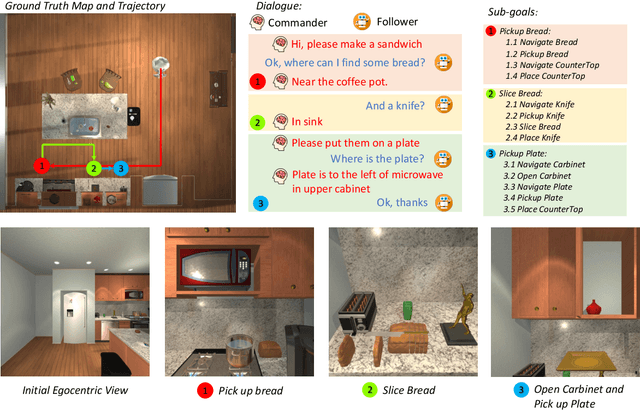

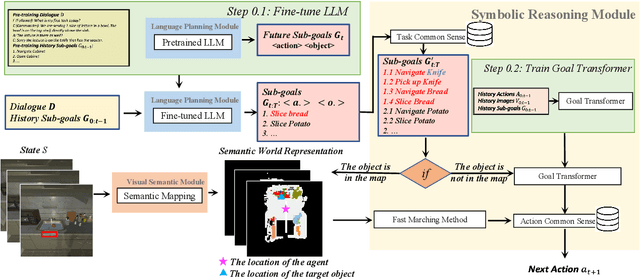

Abstract:Building a conversational embodied agent to execute real-life tasks has been a long-standing yet quite challenging research goal, as it requires effective human-agent communication, multi-modal understanding, long-range sequential decision making, etc. Traditional symbolic methods have scaling and generalization issues, while end-to-end deep learning models suffer from data scarcity and high task complexity, and are often hard to explain. To benefit from both worlds, we propose a Neuro-Symbolic Commonsense Reasoning (JARVIS) framework for modular, generalizable, and interpretable conversational embodied agents. First, it acquires symbolic representations by prompting large language models (LLMs) for language understanding and sub-goal planning, and by constructing semantic maps from visual observations. Then the symbolic module reasons for sub-goal planning and action generation based on task- and action-level common sense. Extensive experiments on the TEACh dataset validate the efficacy and efficiency of our JARVIS framework, which achieves state-of-the-art (SOTA) results on all three dialog-based embodied tasks, including Execution from Dialog History (EDH), Trajectory from Dialog (TfD), and Two-Agent Task Completion (TATC) (e.g., our method boosts the unseen Success Rate on EDH from 6.1\% to 15.8\%). Moreover, we systematically analyze the essential factors that affect the task performance and also demonstrate the superiority of our method in few-shot settings. Our JARVIS model ranks first in the Alexa Prize SimBot Public Benchmark Challenge.
 Add to Chrome
Add to Chrome Add to Firefox
Add to Firefox Add to Edge
Add to Edge